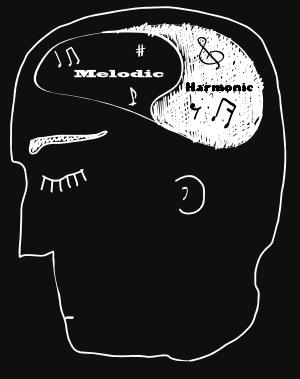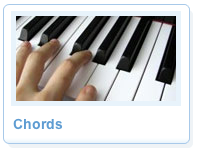Did you know there are actually two different types of ear training exercise? Learn to harness both and you can genuinely double your ear training progress.
If you have a lot of experience with theory classes or with playing in an organized ensemble, you’re probably familiar with these two different (but equally important) types of ear training method.
Melodic and Harmonic Ear Training
Melodic and Harmonic ear training are equally important. When we sit down to practice though, we tend to focus only on one of them: the basic approach of learning intervals: practice-the-interval-until-you-could-recognize-it-asleep memorization method (or derivatives of it, like sight-reading). I like to refer to this approach as “melodic”, as it emphasizes the musical elements of intervals necessary in carrying a tune or solo improvisation.
It’s the second type, “harmonic”, that musicians sometimes forget: training your ear to hear the subtly different types of chords. Practicing one type improves the other, and a well-balanced approach is the fastest way to start hearing results from your training in everyday jam sessions.
In this post we’ll take a closer look at both melodic and harmonic ear training and identify the best techniques for developing them.
Before we move on it’s important to note that any classifications like these are, of course, only effective as basic guides to help these concepts sink in. For instance, you might find it just as helpful to adapt what we’ll refer to as “melodic” methods to do harmonic training, and vice versa. This division between melodic and harmonic ear training is not a fixed rule – just a logical dichotomy between the two general types that, if practiced in parallel, could help you develop a better ear.
Type 1: Melodic Ear Training
Melodic ear training is the type we tend to emphasize – sometimes to a fault! If you’ve ever quizzed yourself on intervals with a keyboard or practiced sight singing, you’ve been training melodically. This type of training can be extremely important in developing the ability to solo instrumentally or in composing vocal melodies, and it will help you become familiar with different types of scales and modes. If, for example, you were working on a song built around a harmonic minor scale, you could practice running the notes up and down to get acquainted with the distinctive characteristics of the scale.
When you’re working on your ear with a melodic emphasis, the ultimate (but also the most challenging) exercise is sight singing. Even if you’re not a singer, practicing sight-singing will give you practice moving between all the notes in the scale and key of your choice, while at the same time providing context for how different intervals can be used in a melody or solo. If you practice sight-reading a melody written in the E Phrygian mode, for instance, you’re genuinely going to hear what makes the Phrygian a unique mode. On the other hand, if you simply ran the scale up and down or practiced isolated intervals, it would be very difficult to distinguish it from a normal C major scale.
If you have friends who are also interested in developing a more sensitive ear, recruit them to your ear training team for this exercise. You should each write a melody, swap them, and practice sight singing from there. This will give you some practice with composition, as well as simplifying the issue of finding material to read that fits the areas you want to focus on. If you don’t have musician friends, Google for finding sight reading exercises, this will work nearly as well.If you’ve never sight-read before, be advised that it might take more practice than you expect. Assign each note a number or a solfege syllable if you prefer. Move slowly, and be patient with yourself. Try reading the melody in your head before singing it out loud, and note any spots of potential difficulty. Then run it through a few times until you can get it perfect. Remember that a consistent error, while frustrating at first, is the easiest way to identify the intervals you need to practice most! This kind of solfa sight-reading practice will do wonders for your ears.
Type 2: Harmonic Ear Training
As a guitarist, my earlier years of practice led me to classify chords in just two ways: “regular” and “jazz”! All I knew was the latter sounded cool and complicated, so I’d look up the voicings online and then inject them haphazardly into my riffs. It took years for me to finally start using chord ear training to learning each chord type in any structured way, but once I did, I made exponentially faster progress as a rhythm player!
The trick is simply to get organized: pick a starting point (e.g. the major seven chord) and experiment with it incessantly until you recognize it built on any note, with any inversion. Then move on to the next one.
It’s really harmonic ear training that benefits most from repetitive memorization, since the main goal here is to learn each chord type’s unique textures and emotional evocations. Each type of chord has a character that transcends the words we use to describe it, so it’s much easier to teach yourself what, say, a major seven chord sounds like than what a “C note” sounds like (because any individual notes will sound different in various contexts). If you become familiar enough with a minor eleven to know one when you hear it, you’ll also be familiar enough with it to know when and where to use it in your own playing. Melodic intervals have more of a distinctive character than individual notes, but it is really harmonic intervals and chords which you can most effectively learn to recognise by their distinctive sound.
Let their powers combine
Most musicians are aware that both melodic and harmonic ear training is possible – and yet, most that I meet are neglecting one or the other! If you simply make a concerted effort to stay sharp with both, your progress in each will quicken noticeably.
Whether you’re looking to compose music, improvise, or just become a more well-rounded musician, dedicating regular time to both melodic and harmonic ear training is a critical step towards virtuosity.









